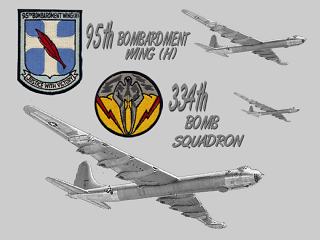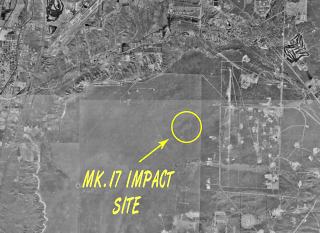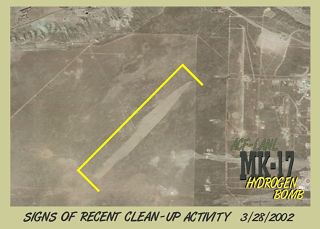
 |
The B-36J (52-2816) carried a double crew that day, consisting of 20 men assigned to the 334th Bomb Squadron. A few were "sandbaggers," non-essential crewmen who needed to pick up some extra flight time. Both crews logged the flight as a weapons training mission. The flight plan was simple: takeoff, navigation leg, and landing. Maj. Donald Heran was listed as the aircraft commander (AC). Capt. Richard Meyer, a career officer with 15 years experience in bombers, was the mission pilot. Maj. Heran requested that 1Lt. Robert Karp (who normally served as navigator/bombardier for the second crew) look after the weapon, a Mk.17 hydrogen bomb. Karp's primary responsibility would be to lock and unlock the weapon shackle release system as required during the mission. Heran determined that Karp was current and proficient in all duties he would have to perform in the bomb bay and was satisfied that he was up to the task.
Ground crews eased the weapon into place beneath the B-36 and hoisted up on a special sling that looked like it was made of giant bicycle chains. Its dark green casing had soaked up the heat of the desert sun. The Mk.17 occupied the aft two of the aircraft's four bomb bays.
A hydrogen bomb has two stages that contribute to the total yield. The primary is the first of these, consisting of nested spheres of plutonium (called the nuclear capsule) that are crushed to critical mass by high explosives (HE). A precisely spherical blast wave is required to produce the desired effect, a fission (atomic) explosion. This in turn crushes the nested cylinders of the secondary stage that ignites a fission-fusion reaction. The cumulative effects occur in a scant fraction of a second, and release enormous amounts of energy that become the expanding fireball.
For safety reasons, the nuclear capsule had been removed from the primary of the Mk.17 prior to transport. Without the capsule in place, no nuclear detonation could occur even if the HE were to explode. This Mk.17, one of 200 built, was being taken to Kirtland AFB for modifications to the fusing mechanism.
Loading operations and preflight checks on the B-36 were completed by late morning. The aircraft's six giant propellers and four turbojets roared to life, and the silver leviathan prepared for takeoff. Lt. Karp left his station in the pressurized aft compartment and entered the bomb bay. He then removed the locking pin and returned to his seat for takeoff. The weight of the weapon and the heat of the day caused the bomber to use a generous amount of runway. The nose wheel lifted off the concrete followed, almost grudgingly, by the main gear. It appeared to be just another routine flight.
As the B-36 climbed away from El Paso, Karp entered the bomb bay and inserted a locking pin into the Type U-2 pneumatic bomb release mechanism. This safety device would prevent an accidental drop of the weapon, even if someone pulled the release handle. Standard operating procedures called for removal and stowage of the pin prior to landing. With the pin removed, the weapon could then be jettisoned if necessary. If an emergency, such as engine failure or fire, made continued presence of the weapon onboard a hazard to the crew or local populace, the Mk.17 could be released (preferably over an unpopulated area). Karp, having installed the pin, returned to the aft cabin for the remainder of the short flight to Albuquerque.
 |
Approaching Albuquerque, Maj. Heran received clearance to land on Runway 27 at Kirtland AFB. The crew began descent procedures and completed the landing checklists. As the B-36 entered the downwind leg at an altitude of 1,700 feet, Karp opened his access hatch and entered the bomb bay. It was 11:50 a.m. when Karp reached out across the top of the Mk.17 and grasped the locking pin. It came out easily with no unusual pressure or stress.
Approximately 20 seconds after the pin came free, the Mk.17 dropped from its sling through the closed bomb bay doors, flooding the interior of the bay with light. The aft six feet of the doors were sheared completely off. Karp watched in shock and amazement as the bomb plummeted towards the desert floor. The great green monster wobbled for a few seconds before its 64-ft. diameter yellow mesh deceleration chute deployed.
Suddenly freed of its burden, the B-36 jumped up hundreds of feet in just a few seconds. A gunner shouted "Bombs away!" Karp quickly contacted Meyer on the interphone and said, "Bomb Bay to AC, we just dropped the blivet!" Meyer breathed a sigh of relief that Karp had not fallen out with the Mk.17 and struggled to bring the bomber back on course.
The Mk.17 fell nose first into a cow pasture several miles south of the Kirtland control tower. Its parachute, designed only to slow the weapon until the delivery aircraft had departed, did not provide for a soft landing. The weapon's high explosive components detonated on impact, shattering the Mk.17. Fragments of the bomb casing and components were ejected as the explosion excavated a 12-foot-deep, 25-foot-wide crater in the desert floor. Some shrapnel flew nearly a mile. Although the nuclear capsule from the primary was still safely aboard the B-36, fissionable materials from the other two stages (as well as contaminated non-nuclear components) were dispersed. According to one source, a cow was killed by flying debris.
 |
Maj. Heran ordered the landing aborted so damage to the bomber could be assessed. The aft scanners reported the partial loss of the bomb bay doors, but found no damage serious enough to prevent a safe landing. Meanwhile, the flight engineer requested the return of the landing data cars. He had to recompute the approach and landing speeds since the airplane's weight had been reduced by about 42,500 lbs. After making another circuit around the pattern, the B-36 landed without further incident.
Response to the BROKEN ARROW, as nuclear weapons accidents are called, was immediate. Recovery and cleanup operations were conducted by Field Command, Armed Forces Special Weapons Project (AFSWP) from Kirtland. "Special weapons," is a military euphemism for nuclear weapons. The AFSWP personnel were trained to deal with just this type of situation which, as chance would have it, had landed practically on their doorstep.
Members of the 2700th Explosive Ordnance Disposal Squadron from Hill AFB, Utah inspected the site. A radiological survey of the impact area disclosed no radioactivity beyond the lip of the crater, at which point the level was 0.5 milliroentgens/hour. This is 25 times the natural background radiation. By comparison, according to the U.S. Department of Energy, the average person receives between 35 and 50 milliroentgens each year just from the sun.
The cleanup crews removed most of the radioactive and other debris, concentrating on fissionable materials and sensitive components. Bulldozers pushed surrounding soil into the crater and graded the surface flat.
 |
The aircraft and crew remained overnight at Kirtland. Investigators interrogated the crew extensively to determine what had happened. An inspection of the B-36 showed that the airplane remained structurally sound. Technicians removed the remnants of the aft bomb bay doors and prepared the bomber for return to Biggs AFB. Per procedures, Maj. Heran needed a signed receipt for delivery of the nuclear weapon. After some difficulty, a high-ranking general officer finally signed for the Mk.17 as "received," but added the comment: "condition unknown."
The accident investigation focused initially on whether or not Lt. Karp could have somehow activated the manual release mechanism. He was ultimately exonerated by the investigating board, which found that Karp had committed no procedural violations, but may have inadvertently triggered the release due to a mechanical fault in the system.
According to the declassified incident report, the proximity of "exposed cable near the U-2 release (mechanism) provided ideal conditions for a release by contact with the cable." The weapon release system was designed to preclude a manual or electronic release without a series of specific actions by authorized crewmembers. A shielded manual release cable extended from the bombardier/navigator's station in the cockpit to the release mechanism. The system also included an interlock to prevent release with the bomb bay doors closed. Unfortunately, several inches of cable adjacent to the release shackle were unshielded. Flexing of the fuselage during flight, or inadvertent crew contact with the exposed cable, could result in release of the weapon once the locking pin was removed.
